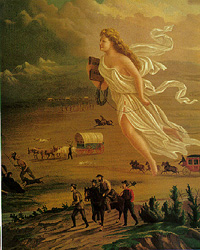John Gast "American
Progress" 1873

|
White
Americans in the age of incorporation subscribed to a linear conception of human
progress. In the "Grand Drama of Progress" the figure of the Native
American represented a "barbarous race," and the lowest level of civilization in
America. John Gast's painting "American Progress," illustrates
in the words of its explanatory text,"the grand drama of progress in the
civilization, settlement , and history of our happy land." The painting demonstrates
both the linear construct of human progress and the marginal place accorded to the
Native American by the proprietors of American progress. |



